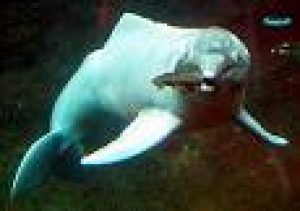
The Amazon river dolphin, otherwise known as the boto, is a freshwater river dolphin found in Southern America. The boto is often referred to as the ‘pink dolphin’, although not all individuals are pink. In fact, DCP learned this week at the Society for Marine Mammalogy’s Biennial conference that it is only the male botos that obtain a pink color, and that this is because of an accumulation of scar tissue. The boto’s natural color is a bluish gray. Male botos engage in aggressive biting matches, which scar their skin, causing bright pink patches to appear. After a lifetime of bites, their whole bodies take on a pinkish color; a testament to a life of aggressive encounters with other males. Botos also have pronounced sexual dimorphism: the males are quite a bit larger than the females. Males can be two and a half meters in length, whereas the females only reach about 1.8 meters. It seems that male botos are special in many ways, and not just when it comes to size and appearance. It now appears that male botos are the only species other than man and chimpanzees that carry objects in order to impress females or intimidate other males. Chimpanzees are known to brandish objects like branches or big sticks in order to show off to other males and females; human males have a huge assortment of bling that we use for similar purposes; but the male boto makes his presence known by carrying rocks, clay and weeds.
Botos had often been observed playing with object found in their environment, and scientists used to think this is exactly what it was: playing. But boto expert Dr. Anthony Martin of the Sea Mammal Research Unit at the University of St. Andrews presented a paper at the Society for Marine Mammalogy biennial conference wherein some important discoveries were presented about this object carrying behavior to suggest that it is not play behavior at all. Over the course of three years, Anthony and his colleagues made 221 observations of botos carrying objects. The dolphins would typically grip the objects in their mouths and sometimes thrash about at the surface while holding the object aloft, or rise up vertically while holding the object before sinking back down again. For the 221 observations, it was found that it was almost exclusively adult and sub-adult males who brandished these objects. The carrying behavior was most often recorded in large groups of males. In groups where object carrying was observed, aggressive behavior was 40 times more likely to be recorded. These two facts suggest that these carrying bouts are in fact aggressive displays put on by males, possibly to intimidate other males. Object carrying was also observed at times of the year most closely associated with female fertility, another clue that this is likely socio-sexual behavior and not play.
Boto object carrying behavior made a brief appearance in the 2006 BBC series Planet Earth hosted by Sir David Attenborough. In the episode called “Fresh Water”, we see a male boto thrashing about a piece of seaweed. Although the documentary claims that a successful object carrying bout leads to mating attempts, Anthony points out that his research team has never once observed any mating behavior by the boto. Genetic evidence, however, does suggest that the males who carry the most objects do end up fathering the most calves, so Planet Earth is probably not too far off the mark.
The boto now joins the ranks of the Indo-Pacific Bottlenose dolphin and the Indo-Pacific humpback dolphin as the only three dolphin species having been observed using objects in their environments. For the boto, the objects are involved in a socio-sexual display, whereas the other two species appear to use sponges as a kind of foraging tool. It could well be that boto object carrying is another potential sign of culture in dolphins: a skill that is passed down from generation to generation. Whether culture or not, the boto’s object carrying is certainly a one-of-a-kind behavior and is very exciting news for dolphin scientists.
[ms_audio style=”light” mp3=”https://www.dolphincommunicationproject.org/wp-content/uploads/2022/05/thedolphinpod4sciencespotlight.mp3″ ogg=”” wav=”” mute=”” loop=”” controls=”yes” class=”dcp-embed-mp3″ id=””]
